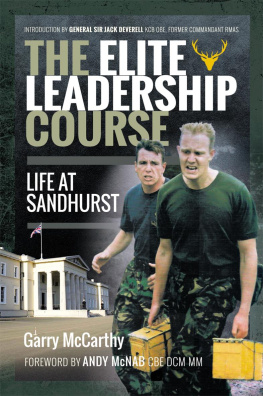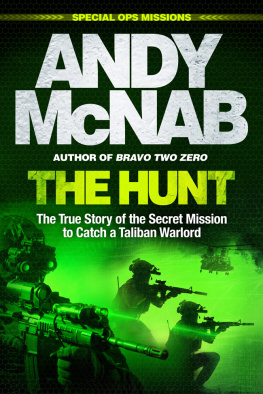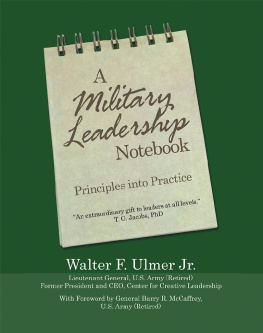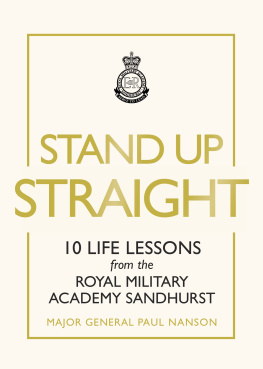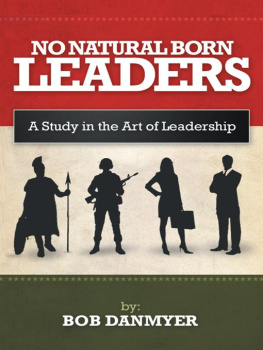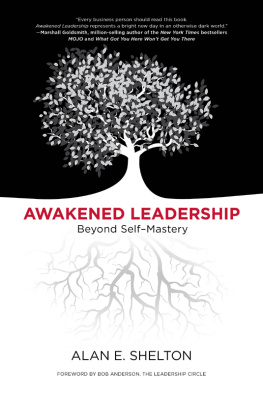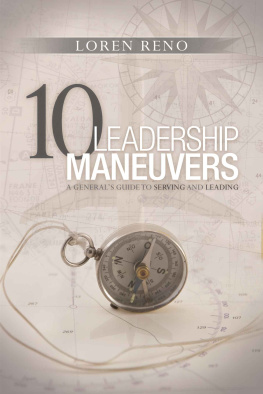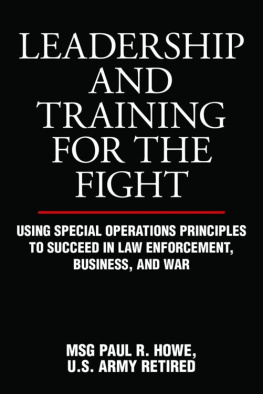The Elite Leadership Course
The Elite Leadership Course
Life at Sandhurst
Garry McCarthy
First published in Great Britain in 2021
by Pen & Sword Military
An imprint of
Pen & Sword Books Ltd
Yorkshire Philadelphia
Copyright Garry McCarthy 2021
ISBN 9781526790491
eISBN 9781526790507
mobi ISBN 9781526790514
The right of Garry McCarthy to be identified as Author of this work has been asserted by him in accordance with the Copyright, Designs and Patents Act 1988.
A CIP catalogue record for this book is available from the British Library.
All rights reserved. No part of this book may be reproduced or transmitted in any form or by any means, electronic or mechanical including photocopying, recording or by any information storage and retrieval system, without permission from the Publisher in writing.
Pen & Sword Books Limited incorporates the imprints of Atlas, Archaeology, Aviation, Discovery, Family History, Fiction, History, Maritime, Military, Military Classics, Politics, Select, Transport, True Crime, Air World, Frontline Publishing, Leo Cooper, Remember When, Seaforth Publishing, The Praetorian Press, Wharncliffe Local History, Wharncliffe Transport, Wharncliffe True Crime and White Owl.
For a complete list of Pen & Sword titles please contact
PEN & SWORD BOOKS LIMITED
47 Church Street, Barnsley, South Yorkshire, S70 2AS, England
E-mail:
Website: www.pen-and-sword.co.uk
Or
PEN AND SWORD BOOKS
1950 Lawrence Rd, Havertown, PA 19083, USA
E-mail:
Website: www.penandswordbooks.com
Preface
M uch has changed since this book was written. In no way does it reflect life at the Royal Military Academy today. Unknown to us all, the officer of the late 1990s would face war waged at a rate of attrition that was, at times, higher than that of the Great War. Regardless of the flaws in the techniques used to train officers at this time, this book is a historical record of how one group were trained for the impending wars in Iraq and Afghanistan in the following decade. This is the extraordinary true story of twenty-one young men battling their way through the greatest challenge any young leader could possibly undertake. It is a unique insight into the industry of making leaders and commanders of the British Army, the likes of which has never been told before. Physically brutal, emotionally draining, the intensity of scrutiny is not replicated in any other form of leadership training. For the precious few who make it through, they reflect on this period of their lives as the most defining. They form a special group of men carrying the torch of every leader that fought in both World Wars.
Thirty years have elapsed since the chain of command denied publication of this account, and much has changed; this account has very little in common with what happens at Sandhurst today. Training servicemen and women for modern- day conflict is now highly regulated and scientific. But during the desperate times of war, when time is at a premium, we turn to our experiences to deliver what is needed. Leadership training must change with the times and synergize with global and regional atmospherics. Sandhurst has exemplified this concept and constantly reassessed course content and training methods to meet these changing dynamics. Consequently, there is little correlation between the content of this book and how training is delivered at Sandhurst today.
This story captures the most unique period during one of these changes. Built around the principles of Lord Rowallans Highland Fieldcraft Training Centre, established in 1943 to develop character, Sandhurst introduced its own version of the course in 1977. The course remained unchanged until it was disbanded in 1999, although it has made several reappearances in different disguises ever since. The people in this story are real, although to protect their identities names have been changed and characters merged. The account is as accurate as possible, given the lapse of thirty years since these events occurred. Some events and dates are deliberately skewed to prevent causing offence to those involved or still serving. In addition, some locations and theatres of operations have been substituted for similar environments that keep the events believable.
Introduction
I t is hard to imagine a time when a book on leadership could be more relevant. The pandemic created by the spread of COVID 19 will change many things in the world, and not simply what we do and how we do it. It will equally influence our view of the world and our place in it. As assessments of the national and international consequences of the virus begin, a critical eye will be focused on the quality of decision-making and the effectiveness of leadership within governments and institutions. It will be important to analyse how governments and institutions reacted to the spread of the virus and to determine how effective had been the preparation for such an event.
Decision-making and leadership are two crucial components of military Command. Outside the military and other emergency services, leadership is seldom considered an integral part of education or training. More often than not, such matters are covered in any depth only when individuals are about to undertake what might be deemed to be leadership roles. Even then, the focus is likely to be on what leaders have to do rather than what they have to be, whereas behavioural characteristics are regarded by the military as an essential element of the moral component of military capability. They are the basis of selection and a persistent training theme throughout a soldiers service.
It is easy to forget that leadership skills are a necessity at every level of an organization and that small group leadership is essential if higher level leadership is to be effective. It is no accident that military training focuses on developing command ability at the earliest stages of training: from Officer Cadet and Junior Non-Commissioned Officer upwards. And yet what are the practical, legal and moral expectations placed upon those who are being led? During initial training, soldiers are being given the practical skills they require to do their job. They are also being taught how to follow. Followship (if it can be termed that) can be defined as the acceptance of the authority of another person and willingness to carry out their instructions. Such authority may be derived from the State or an institution, or it may be informal. Good followship is born of good leadership; but leadership and followship are two sides of the same coin. During an era in which the concept of the individual is in the ascendency, it is too easy for the idea of followship to be associated with disempowerment and lack of autonomy, even servility, discrimination and exploitation, and tag them with a label marked bad. Yet without the practice of followship, effective leadership is, at best, very difficult and, at worst, quickly undermined.

